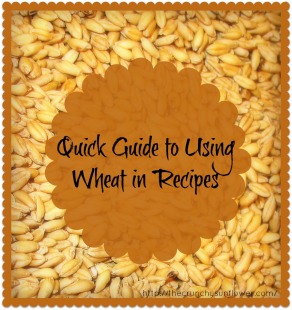 Several years ago, scooping out the flour for my recipes, I rarely thought about the flour itself. At that time, I was primarily focused on learning to bake and finding the right recipes for my family. I was simply doing well to bake the various muffins, breads, and cookies. Cooking from scratch was an accomplishment at the time, and so I thought little about using anything other than all-purpose flour.
Several years ago, scooping out the flour for my recipes, I rarely thought about the flour itself. At that time, I was primarily focused on learning to bake and finding the right recipes for my family. I was simply doing well to bake the various muffins, breads, and cookies. Cooking from scratch was an accomplishment at the time, and so I thought little about using anything other than all-purpose flour.
That was, until my husband told me about his family’s experiences with grinding their own flour at home. “What?” I asked. “You know that stuff comes ground already, right?” That’s how it ended for the moment, but I continued to think about the concept and the benefits of grinding our flour at home. After several months of cogitating on the topic and researching it, I decided to give it a try. I ordered a grinder as well as some wheat berries and waited.
When the big day came, I excitedly opened the packages, revealing the shiny, new wheat grinder and dipping my hand into the wheat berries. I was new to the process, but I was ready to give it a try. I was so enthusiastic that I quickly ground the flour and began baking some biscuits for myself and my husband. The result? Well, the result was less than tasty. The biscuits were more like hard little pebbles of wheat. Not exactly the best way to begin a new method of cooking.
With all of the information out there on wheat and its use, it can be a bit overwhelming to get started. That’s where I come in. Even if you are as thrilled to get started with grinding your own wheat as I was, you don’t have to make the same mistakes. Too, I have since done the reading necessary to use the flour effectively. No more wheat-y pebbles for us.
So what do you need to know to get started with wheat right away? Here are some tips:
- You will see hard wheat and soft wheat when you are shopping. Hard wheat can be used for making breads, and soft wheat can be used in recipes for muffins, cakes, cookies, etc.
- White wheat is often more palatable than red wheat. Red wheat is a bit nuttier in taste than white wheat, and so the latter is better to use in the beginning if you’re used to the taste of all-purpose flour.
- Only grind a small amount of wheat at a time. You can store spare flour in the freezer to prevent spoilage.
- You cannot use your freshly ground flour in just any recipe. Learn from my biscuit mistake! Look for recipe books that specialize in recipes that use freshly ground flour, usually food storage cookbooks. One of my favorites is Wheat Cookin’ Made Easy.
- Go slow on introducing whole wheat into your diet. This will help ease your digestive system through the change.
So does this mean that you must throw away all of your recipe books? No, it sure doesn’t. Let’s say you have a favorite bread recipe that uses three cups of store-bought, whole wheat flour. This store-bought, whole wheat flour is much different from what you will grind at home. To use your freshly ground flour in this type of recipe, simply use half of your own freshly ground flour, with the remaining half being all-purpose flour. By using the half and half method, you can use your own fresh ground flour in any recipe that specifies whole wheat flour.
And that’s it! These are the bare bones of what you need to know when using whole wheat in your baking. If you’re impatient like me, you often like to dive in to something without doing a lot of research beforehand. By learning from these quick tips, then you can get started with grinding your own flour and forgo the mistakes that I made so long ago.
